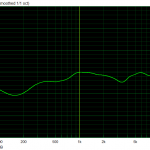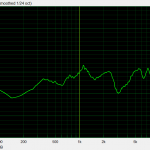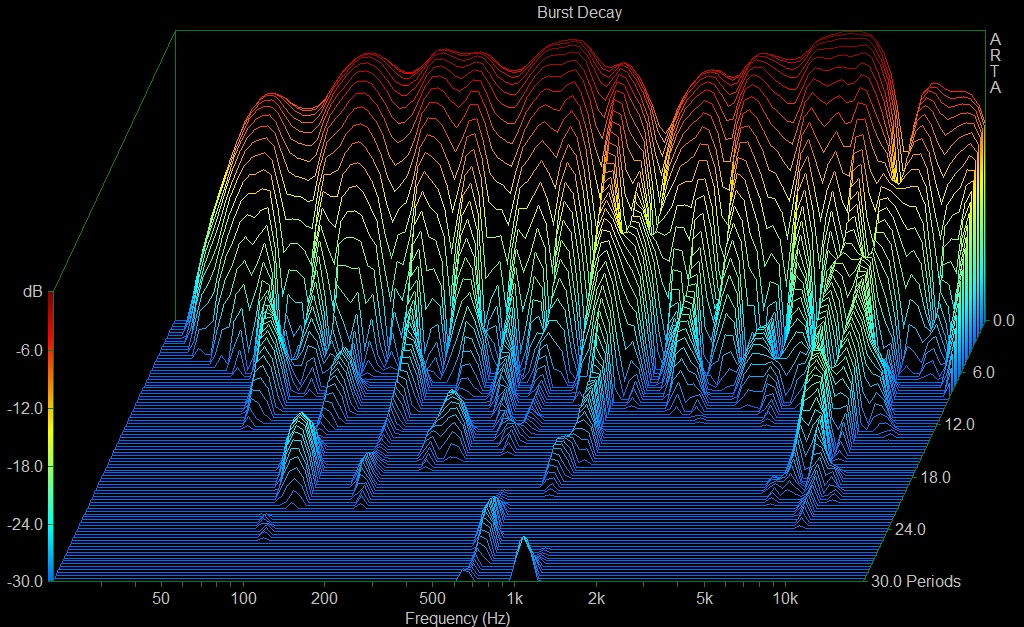Frequency range and course
The measured frequency curve is good and not even a bathtub if you leave everything on default. With the app's equalizer, however, a decent height and bass increase is possible, which everyone should really adapt to individually, if they want to. However, I don't measure exactly that now, but only what you get as a neutral setting at the 3.5 mm blade input. And that looks really good for this price situation! More bass always goes, of course, but then contouring and crispness subside.
Burst Decay
The cumulative spectrum denotes different types of diagrams that show time-frequency properties of the signal. They are generated by successive application of the Fourier transformation and suitable windows to overlapping signal blocks. These analyses are based on the frequency response diagram already shown above, but also contain the element time and now show as a 3D graphic ("waterfall") very clearly how the frequency response develops over time after the input signal stopped. In colloquial terms, such a thing is also called "end" or "swingout".
Normally, the driver should also stop as fast as possible after the input signal has been dropped. However, some frequencies (or even entire frequency ranges) will always subside slowly and then continue to appear in this chart as longer-lasting frequencies on the timeline. This is a good way to see where the driver has glaring weaknesses, perhaps even "squealing" or where, in the worst case, resonances may occur and disturb the overall picture.
For many reasons, I do not use diagrams that generate plots in the time range (ms) (CSD, STF), but at the request of the more ambitious readers with the burst-decay plot now rely on a representation in periods (cycles). And while both methods have their advantages and disadvantages (or limitations), it can be said that the presentation in periods may be more useful to determine the subsidence of a headphone with a wide range.
You can see on the graphics very clearly the slight reverberate of the drivers in the upper bass, the middle and even in the super high tone. That's the only thing that bothers me a little bit when i sound the headphones. Well, there are genres where that even fits, because especially the vocals sound more voluminous than they are, but Hi-Fi isn't quite that anymore. To understand us correctly, this is far from bad, but it is also not top class. If you look at the price, you can certainly turn a blind eye, especially since the more inexperienced listener will not even notice it. Fun listeners are different, which is only positive.
Let us now come to the subjective assessment of things and simply leave the measurement curves to the left. The assessment is based on the middle position of the controllers (default). And since the headphones already have a decent set of operating hours on the hump, the play-in faction is also allowed to breathe.
Bass
Test the lowest bass in the subcontraoctave (16.4 Hz to 32.7 Hz) with a recording of Bach's Toccata and Fugue in D minor (19 and 25 Hz) and the Festival Overture 1812 by Tchaikovsky (10 Hz and 12.5 Hz). The same applies to the lower ranges of the contraoctothe (32.7 to 65.4 Hz). The big bass drum (kick drum), which in the U-music is a welcome companion and usually on approx. 55 to 60 Hz, this assessment will then be rounded off.
The bass is good, deep and yet not over-represented. The bass is cleanly perceptible and even the subcontraoctave can still play mercifully. If you want more pressure here, you can use the equalizer of the app, but then lose level strength and contour. Something more is always possible, but you must never overdo it. It doesn't really get deeper, it's just a lot louder.
The upper bass up to 150 Hz, in which also the Great Octave (65.4 to 130.8 Hz) is located, houses the basic language frequency of the male voice and decides very strongly on the true-to-life reproduction of male vocals.
This area sounds nicely balanced and natural. The male vocals are well played, but not too warm or even concise. Moreover, the instruments are hardly distorted, but they weaken somewhat in the presence. Overall, the resolution is astonishingly high and allows orchestral pieces, rock, pop and jazz of all stripes to perform well. It is important that the headphones are well attached, otherwise there is mud, which of course also applies to the bass.
Frequency range
The lower middles (also basic tone range) are approx. 150 to 400 Hz. Together with the already mentioned upper bass, this area plays a very important role for the subjectively perceived heat or bass. Fullness of the sound. The basic language frequency of female voices can be found in this area.
Here, too, there is no reason to criticise, nothing rattles or buckles, on the contrary, everything remains well modelled. Female vocals come to the point and the timbre of the vocals and recorded instruments is rather warm, but never cold and analytical. The further upward trend is also free of criticism. The precision is average and makes the system a good all-rounder in all musical situations.
The upper mids between 400 Hz and about two KHz contain a mark at a KHz, which is still considered a reference for many measurements. Unfortunately, this is often noticeable with cheaper devices, as manufacturers often try to overemphasize this frequency. This area does not play an insignificant role in gaming either, and balanced playback contributes significantly to good spatial resolution.
The stage and the subjectively perceived quality of the spatial resolution is at an astonishingly high, if not the highest level, which is certainly due to the price. An orchestra still seems (purely subjectively) still positioned far enough and it is possible to locate individual instruments quite clearly and unambiguously at different overall levels. Speech playback is also not lost in this area, no matter how many sources are mixed.
The slight increase in the level in the range of approx. 1 KHz is painful and often makes the headphones appear louder than it actually is. I cannot judge whether this was so intentional or rather coincidental. I wouldn't condemn it, because it doesn't bother.
High-pitched range
Between two and about 3.5 KHz, human hearing is most sensitive, especially since this area of the lower heights is responsible for the good overtone reproduction of the human voice. This frequency range is crucial for the recognition of a voice or instrument; in this context, one also speaks of the respective timbre.
The playback in this area is also free of criticism and the speech intelligibility as well as the quality of the vocals can definitely convince.
The middle heights (3.5 to six KHz) decide on the sound or failure of the speech reproduction as a whole, because the S- and hissing (Sibilants) fall into this range. The upper heights then reach up to approx. ten KHz to move into the super high tone.
High and super high tone are good, even if it goes higher. Sibilants and breathing sounds are accurately depicted, but not overemphasized. It also never sounds pointed or metallic, but very natural, which is also due to the strange but very narrowband burglary at a good 8 KHz. String instruments are not audibly falsified and rather filigree strings are not degraded to recorders. Even a drum remains one, right down to the softly painted jazz brooms, which can really go under the skin. So you can leave it as it is. The height increase in the equalizer is unnecessary and one should avoid this as much as possible.
Summary and conclusion
For the current street price of approx. 230 Euro (black from approx. 200 Euro) is therefore the Jabra Elite 85h a purchase recommendation, even if other headphones perform a little bit better in some areas. The universal AND of a Roughly Equal Bose Quiet Comfort 35 II is certainly better in some situations, but the Jabra also learns. But you have to start the analysis every time and optimize it (situationally), which is a bit stressful. Soundally, however, the Bose is again behind due to the (for me) unpleasant bass load.
A Beoplay H9 sounds better, but it costs twice as much and only lasts a little more than half the time with an ANC battery. A loan-tested Beats Studio3 Wireless works even shorter, sounds worse and costs significantly more. A Bowers & Wilkins PX, along with the Beats, say goodbye to the service quite quickly, as the battery is also very weak. Sound-like, the headphones aren't even bad, but the ANC shows weaknesses.
The four big B can therefore be confidently opposed to a J, even if it is never enough for the complete class victory. In the sum of all the features, however, the Jabra 85h is really good, because what's the point of a headphone that sounds a little better, but rather slimmer or whose limited ANC almost counteracts the higher price? From this point of view, the Jabra is a kind of all-rounder, who can do nothing best, but convinces in the sum of all things.



































Kommentieren